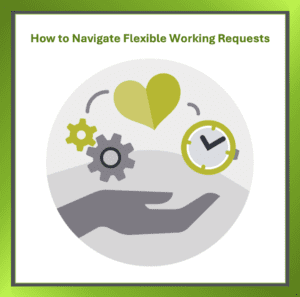How to Navigate Flexible Working Requests
Flexible working has long been a shared aspiration, and with changes introduced in April 2024, it’s back at the top of every HR agenda. Employees can now request flexible working from their very first day in a new role, which raises important questions for employers: How do we handle these requests fairly?

Balancing flexibility and business needs: clear policies, engaged managers, and a culture that supports flexible work.
How do we balance personal needs with business requirements? And how can we ensure decisions are fair, consistent, and legally compliant?
The good news is that with a clear policy, informed management, and a supportive culture, you can embrace flexibility without compromising business outcomes. Here’s a practical guide to get you started.
Start with a clear policy
- Create an accessible flexible working policy that explains how to request, what the process looks like, and what types of flexibility may be possible (remote work, compressed hours, job sharing, and more).
- Ensure new hires know exactly how to initiate a request from day one, setting expectations from the outset.
Train your managers
- Managers are typically the first point of contact for flexible working requests, so they need solid knowledge of the rules and the organisation’s evaluation criteria.
- Provide guidance on the eight valid business reasons for refusing a request, and practical steps for assessing each case fairly.
- Include training on identifying and mitigating bias both conscious and unconscious so decisions are objective and consistent.
Be open from the start
- Since requests can be made on day one, discuss flexibility during recruitment and onboarding. If a role can be done remotely or with flexible hours, say so.
- This early transparency signals that your workplace genuinely supports varied ways of working and helps attract a broader pool of talent.
Treat every request seriously
- Approach each request with careful consideration of the role, team dynamics, and business needs.
- If full flexibility isn’t possible, explore workable compromises such as a trial period or a hybrid arrangement.
- The goal is engagement through conversation, not just ticking a box.
Keep things fair and consistent
- Apply the same standards to everyone. Avoid approving one request while denying another without a clear, documented reason.
- Maintain thorough notes, document the decision process, and articulate the rationale to demonstrate fairness.
- Ensure flexibility is about the role and business needs, not about the individual alone.
Embed flexibility in your culture
- Policies alone aren’t enough. Build a workplace culture that encourages creative thinking about how work gets done.
- Regularly check in to see what’s working and what isn’t and be ready to adjust as needed.
- A culture of open dialogue around work arrangements helps sustain both employee satisfaction and productivity.
Practical next steps
- Review your current flexible working policy and alignment with 2024 changes.
- Develop a manager training module focused on fair assessment, legal considerations, and bias awareness.
- Integrate flexible working discussions into onboarding and recruitment materials.
- Establish a simple, transparent request process with clear timelines and documentation templates.
- Set up regular check-ins to assess the effectiveness of flexible arrangements and iterate.
If you would like to discuss this further, please call our team on 01522 448 181
